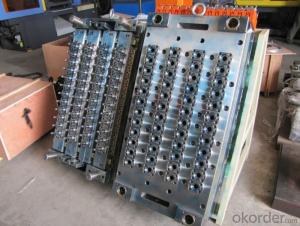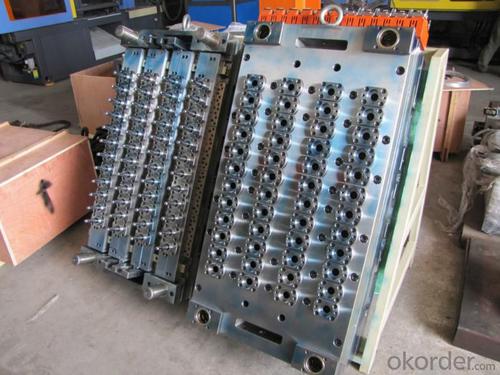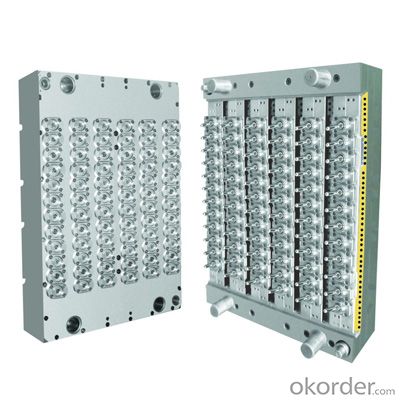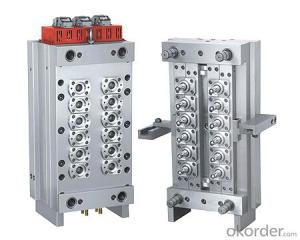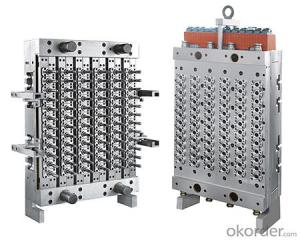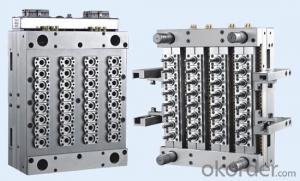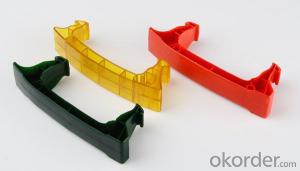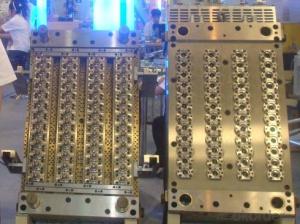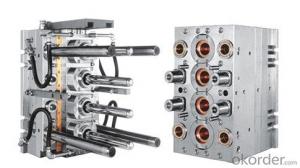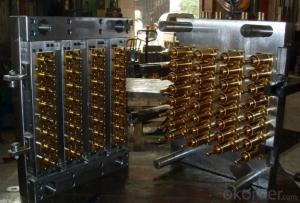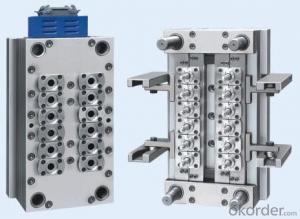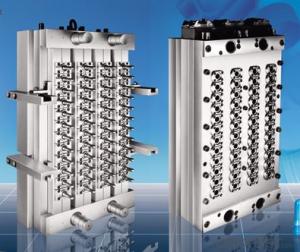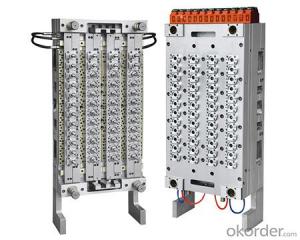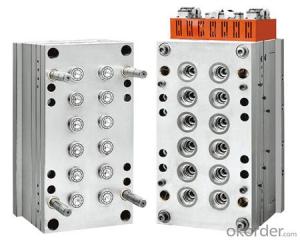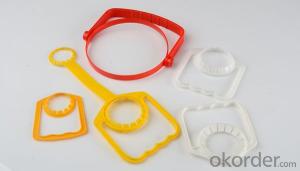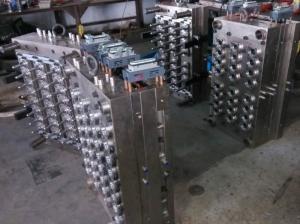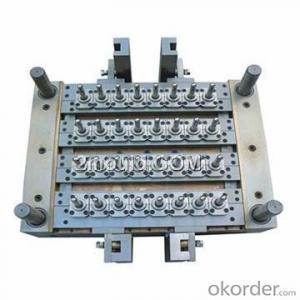PET Preform Preforma/Make PET Mould for Injection China Supplier
- Loading Port:
- Shanghai
- Payment Terms:
- TT OR LC
- Min Order Qty:
- 1 set
- Supply Capability:
- 100 set/month
OKorder Service Pledge
OKorder Financial Service
You Might Also Like
PET Preform Preforma/Make PET Mould for Injection China Supplier
Name: | Plastic pet preform mould |
Specification | Depends on your requirements |
Mould base | LKM&HASCO DEM standard…etc |
Steel of Cavity&Core | S136/DIN1.2316/DIN1.2738/M300/718/2344..etc |
Product material | ABS,PPR,PP,PE,POM,PPH…etc |
Mould standard | DME,HASCO,CHINALKM,MEUSBURGER standard… |
Cavity | Single/Multi |
Hardness of Cavity&Core | 42-56HRC |
Pulling system | stripping plate,angel pin,motor/oil cylinder… |
Mould life time | 500,000-1,200,000shots |
Runner | Hot/Cold |
Value-added service | Diamond polish,paiting |
Delivery time | 30-65 work days |
Package | Wooden case according pointing |
1.R&D | We support customer R&D and improve the design if you needed. |
2.Negotiation | Quality, Price, Material, Delivery time, Payment item est. |
3.Place an order | We offer 3D drawing or according to your own design |
4.Mould
| A: We will build the mould according to customers' request B: We will mould design to customer for first approval C: We will sent samples to customs for confirmation until it meets your requests. |
5.Payment | 50% advance payment, then the customer sent balance to us before shipping |
6.Delivery | Delivery goods by sea or by air, according customers requirement. |
Our Services
1. Can supply with both Mold & Molded parts
2. Provide Milled Prototype Making, Mold Design, Mold Making, Mold Testing, Molding, Products assembly...services
3. With more than 25 years experience, all of works are done 100% in our factory in Taiwan!
4. Low volumes / Small orders are welcome! Please contact us to discuss case by case.
5. Accept only OEM / ODM / Customer Projects. We do not have any existing molds for sell.
6. Mold building lead time: Around 40-50 days, with 1st Mold trialing report and Mold trailing samples
Product Description
Plastic materials: | PS, ABS, PP, PVC, PMMA, PBT, PC, POM, PA66, PBT+GF30%...etc. |
Other materials: | Rubber, Silicone rubber, LSR, aluminum, zinc...Metal...etc. |
Quality: | ROSH and SGS standard |
Feature: | Non marking and Non flash |
Size: | According to your drawing |
Color, Quantity, Unit price, Tooling cost, Tooling size: | To be discussed |
Mold structure: | Injection Mould, Plastic Mold, Overmould, 2k mould, Die-Casting Mould, Thermoset Mold, Stack Mold, Interchangeable Mold, Collapsible Core Mold, Die Sets, Compression Mold, Cold runner system LSR Mold,…etc. |
Mould Base: | HASCO standard, European standard, World standard |
Mould Base Material: | LKM, FUTA, HASCO, DME, etc. or as per customer’s requirement. |
Surface Finish: | Texture (MT standard), high gloss polishing |
Finish: | Mirror finish etc. |
Cavity / Core steel: | P20, 2311, H13, 2344, Starvax 420, 236, AdC3, S136, 2312, 2379, 2316, 2083, Nak80, 2767 etc. |
Cavity: | Single cavity, Muti Cavity, based on customer’s requirement. |
Hot / Cold Runner: | HUSKY, INCOE, YUDO, HASCO, DME, MoldMaster, Masterflow, Mastip, Taiwan made brand…etc. |
Mould Life: | 1,000 to 1,000,000 shots (according to your working environment) |
Design & Program Softwares: | CAD, CAM, CAE, Pro-E, Solid works…etc. |
Equipments: | High speed CNC, standard CNC, EDM, Wire Cutting, Grinder, Plastic Injection Molding Machine for testing mold from 50-3000T available. |
Package: | Standard exported wooden box packed, fumigation process (upon required) |
Mold building lead time: | T1, 40~50 days, parts measurement report (upon required). |
Annual production: | 250 sets of mold |
- Q: How do H13 mould steel heat treatment
- 2. The quenching and tempering toughness good die quenching process specification: heating temperature of 1020 ~ 1050 ℃, oil cooling or air cooling, 54 ~ 58 HRC hardness; For hot hard mould quenching technology, heating temperature of 1050 ~ 1080 ℃, oil cooling, 56 ~ 58 HRC hardness. Recommend a tempering temperature: 530 ~ 560 ℃, 48 ~ 52 HRC hardness; Tempering temperature 560 ~ 580 ℃; 47 ~ 49 HRC hardness. Tempering should be twice. At 500 ℃ tempering, tempering the secondary hardening peak, tempering hardness, the highest peak at about 55 HRC, but toughness is the worst. Therefore, tempering process to avoid around 500 ℃ advisable. According to the use of mould need, within the range of 540 ~ 620 ℃ tempering. Quenching heating should be two preheating (600 ~ 650 ℃, 600 ~ 850 ℃), in order to reduce heating process to produce thermal stress.
- Q: Is there a difference between die and CNC
- Need to master the tools design process of the tools and materials required for the performance of the design of CNC is mainly for nc machine tool operation, need a digital programming reference drawings
- Q: What is die parting face?
- For example: a plastic ball, it is of two quasi semicircle, looked closely, can see a circle line is the parting surface, if it is a big a small half sphere of clamping, can't do that most of the ball out from the mold. So the parting face should be easy to make, easy to make, low cost of making, and some of the addition of insert and exit.
- Q: How many products can a mold make?
- Associated with the material of mould and casting method, had better use a scale of 0-8000 pieces of aluminum mould (ordinary sand casting), 0-13000 pieces (molding machine), plastic mold is bad to use, steel is the most strong, but not suitable for manual operation.
- Q: What is the design philosophy of the mould?
- The domestic development situation of facing the 21st century, the enterprise to adapt to the development of market economy, as the national support industry of the automobile industry will increase production of light, the micro, cars, thus puts forward higher requirements on the precision of the die forgings. In the process of production, improving die life is a complex and comprehensive problem. All forging technology, especially the net net shape and approximate shape processing technology, to a large extent depends on the precision and quality, mould depends on the skill level of the mould. Mould technology is reflected in die design and manufacturing, and die life is related to the use of the process. ? Is of great economic benefit to improve die life, generally in the trial production mold tooling costs accounted for about 25% of the cost of production, and finalize the design production is only 10%.
- Q: The difference between wire cutting and mold making
- The mould as a kind of high life special technology equipment, has the following production characteristics: (1) it belongs to single, multi-breed production. Mold is the high life of special process equipment, each pair of mould can produce a certain shape, size, and the precision of parts, it's decided to mold production belongs to the nature of the single, many varieties, production procedures. The mould production cycle is short. Due to the acceleration of new product upgrade and market competition, the requirement of the mould production cycle is getting shorter and shorter. The mould production management, design and process should meet the objective requirements. (3) the complete set of mould production. When some parts need more pair of mould processing, often involvement and influence each other between each pair of mould, only the final qualified parts, it qualifies as a series of mold. Therefore, this feature must be fully considered in terms of production and planning.
- Q: What is the difference between a mold and a handboard?
- Although there are so many differences between planks and mould, but they still have contact, generally use hand-board model to the customer to confirm the shape first, confirmed to open mold production. The cost of many physical molds is generally high, with large molds valued at 100,000 or even millions, especially in the medical industry. If there is a structural unsound or other problem in the process of installing the die, it will be very large. The handboard model can solve the problem of this loss, reducing the risk of making physical models.
- Q: How do you handle the die holder
- Under external force, the material is made into a special shape and dimension. Widely used in cutting, forging, cold heading, extrusion, powder metallurgy parts suppression, pressure casting, as well as engineering plastics, rubber, ceramics and other products of the molding or injection forming. The mold has a certain contour or inner cavity shape, and the shape of the blade can be separated by the shape of the outline. The inner cavity shape can be used to obtain the corresponding solid shape. The mould usually includes two parts: the moving model and the mold (or the punch and the concave), which can be divided into two parts. When apart, take out the pieces and put them into the mold cavity forming. Mold is a precision tool, complex shape, bear the expansion force of billet, the structural strength, stiffness, surface hardness, surface roughness and machining accuracy have higher request, the development level of mold production is one of the important symbol of the levels of mechanical manufacturing.
- Q: Why are the stamping molds wrinkling?
- The pressure side is small or the clearance is large, please check carefully.
- Q: What is the difference between the mold and the numerical control? The difference is?
- The design process of the tool and the performance of the materials needed are designed CNC is mainly for nc machine tools, need programming digital controlled drawing mould, in short, the mould is used for molding tool, this tool has all parts, different mould made up of different parts. It mainly USES the physical state of the forming material to realize the processing of the physical appearance. The mold can be divided into metal mould and non-metallic mould according to the material that is formed. The metal mould is divided into: casting mould (non-ferrous metal casting, steel casting) and forging die etc. Non-metallic mold is also divided into: plastic mould and inorganic non-metallic mould. And according to the material of the mould itself, the mold can be divided into: sand mold, metal mould, vacuum mold, paraffin mold and so on. With the rapid development of polymer plastics, plastic mould is closely related to people's life. Plastic mould can be divided into: injection molding mold, extrusion molding mold, gas auxiliary molding mould and so on.
Send your message to us
PET Preform Preforma/Make PET Mould for Injection China Supplier
- Loading Port:
- Shanghai
- Payment Terms:
- TT OR LC
- Min Order Qty:
- 1 set
- Supply Capability:
- 100 set/month
OKorder Service Pledge
OKorder Financial Service
Similar products
Hot products
Hot Searches
